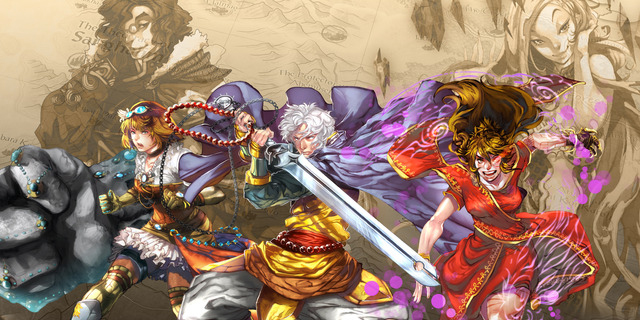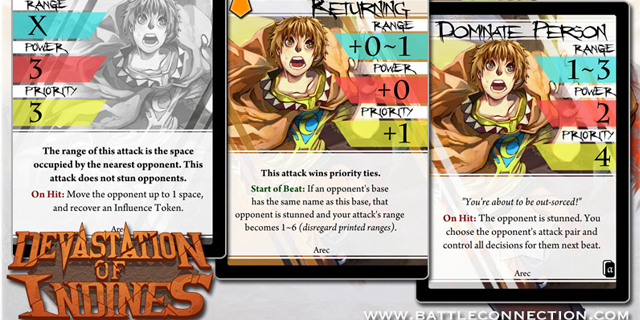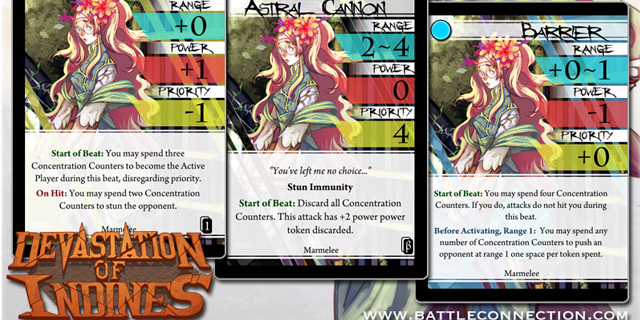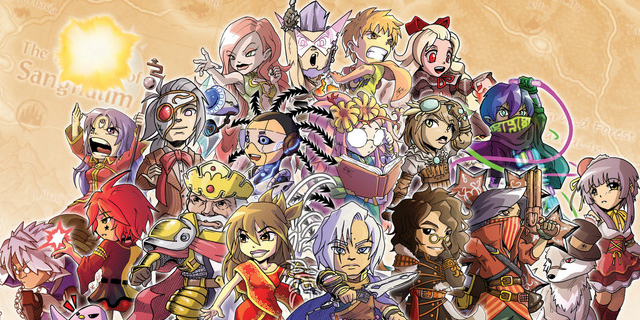
One-on-one fighting games have been a mainstay of gaming culture ever since Street Fighter II dragon-punched its way into arcades. The intricate dance of move and counter-move has played out for decades, and in 2010 Level 99 Games designer (and one-time Snackbar contributor) Brad Talton managed to translate that into a deceptively-simple card game system. Dubbed BattleCON (“Battle Connection”) due to the way players play pairs of styles and bases, the system made its debut in War of Indines after a successful Kickstarter campaign.
To say that the game won over a few fans might be considered an understatement, when you look at what happened with the campaign to fund the follow-up, Devastation of Indines. Blowing past its original goal to the tune of being over 500% funded, a truly mind-boggling final product was created. Everything about Devastation is bigger and better.
Devastation boasts 30 non-boss characters, divided evenly into five flights of increasing complexity to ease players into the game. Each character has a unique base card and five styles, that are combined with the generic bases to create various attack pairs each beat (turn). Many characters also have tokens, counters or other markers that relate to the fighter’s Unique Ability, explained on the character’s main card. Every fighter is different, although some stylistic similarities can be seen across the flights.

Each beat features players secretly selecting an attack pair, consisting of one style and one base. The style will affect the base’s range, power and priority values to create a personalized attack. Whichever player has the higher modified priority executes an attack first, and then the reactive player gets to do the same, assuming the fighter hasn’t been stunned by the opponent’s move. There is a two-beat “cooldown” before a given pair becomes available again, preventing players from just spamming the same attack over and over.
The “stun” system is what makes BattleCON shine, as every tactical choice is basically made around not being stunned in case your priority is the lower value. Different fighters have different approaches to solving this problem. Some emphasize blazing speed, hoping to effectively stun-lock their opponent by always acting first. Others rely on soaking up damage or having enough stun guard to deliver a backbreaking counter-attack. There are also ranged fighters that prefer to use maneuverability and long-distance attacks to outright avoid their opponent and hit back safely. That all of these styles and more can all be represented by the same basic system is truly brilliant design.
There are so many potential combinations of fighting styles that they might as well be endless. And that’s just the basic version of the game. Included play variants include finishing moves, ultra-powerful fighters, arenas, tag-teams and handicap fights (two vs one, three vs. one), plus four boss fight scenarios that puts one player in control of a gigantic threat with their own rules for play while a team of traditional fighters tries to take them down. No matter what variants you add (and several can be mixed and matched), the core play remains smooth, thanks to consistent terminology and a clearly-defined turn structure.

If there is a flaw to the design of BattleCON, it might be the one-on-one nature of the battles. While several team variants exist, there aren’t enough materials in the box to, say, run a tournament that a game like this almost demands. Even considering that there are four sets of bases and life counters, there is only one beat counter, and one board. War owners have a combined access to eight base sets and two boards (albeit one extremely small), but that still seems insufficient. This isn’t a deal-breaker by any means; any number of phone apps or even life counters for other games can pick up the slack, and all you really need for the board is seven or nine marked spaces. But it still seems something of a missed opportunity.
Also, this is not really a game for casual players, although they can certainly enjoy pick-up games. This is a game that rewards learning the ins and outs of each character, just like the video games that inspired it. A group playing somewhat randomly in between other games almost seems like an insult to the sheer options contained in this box. Unfortunately, this is the position in which I find myself. I love everything about this system, but I can’t see me really getting the most out of it while still playing all of the other games that will come to the table. I don’t even think I’ve played more than a handful of full “best of three” matches yet, instead just playing one round at a time while teaching a new player before moving on to something else. Play is quick enough, but while learning one round can take as long as a full match between experts (between 30 and 60 minutes).

Devastation of Indines really feels like it wants to be the only game you own. I almost wish it could be, just to give it the respect it deserves. I definitely feel like I’ve received more than my money’s worth (MSRP $75) in terms of content, however I fear that I will never get my equivalent in play time — through no fault of the game itself.



















